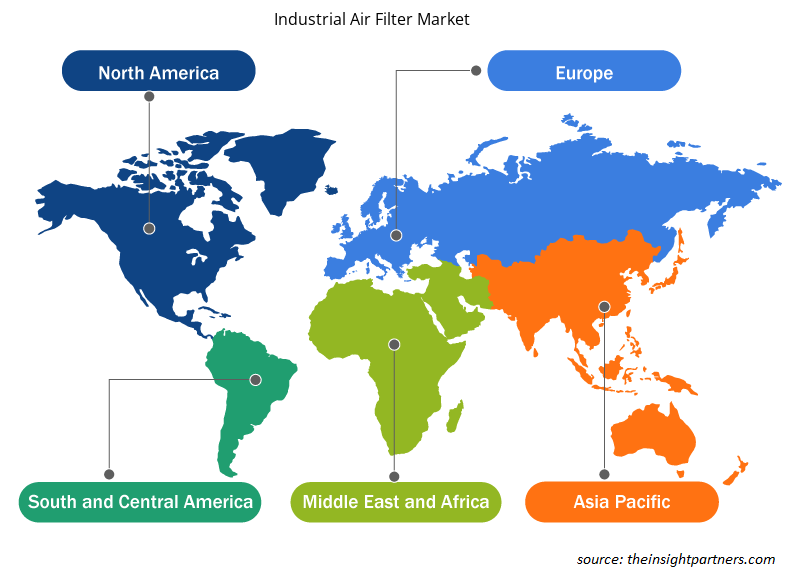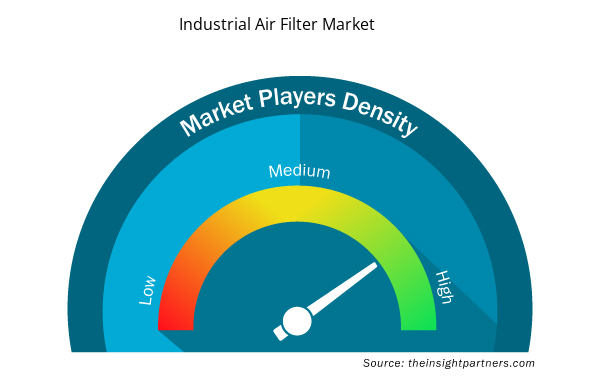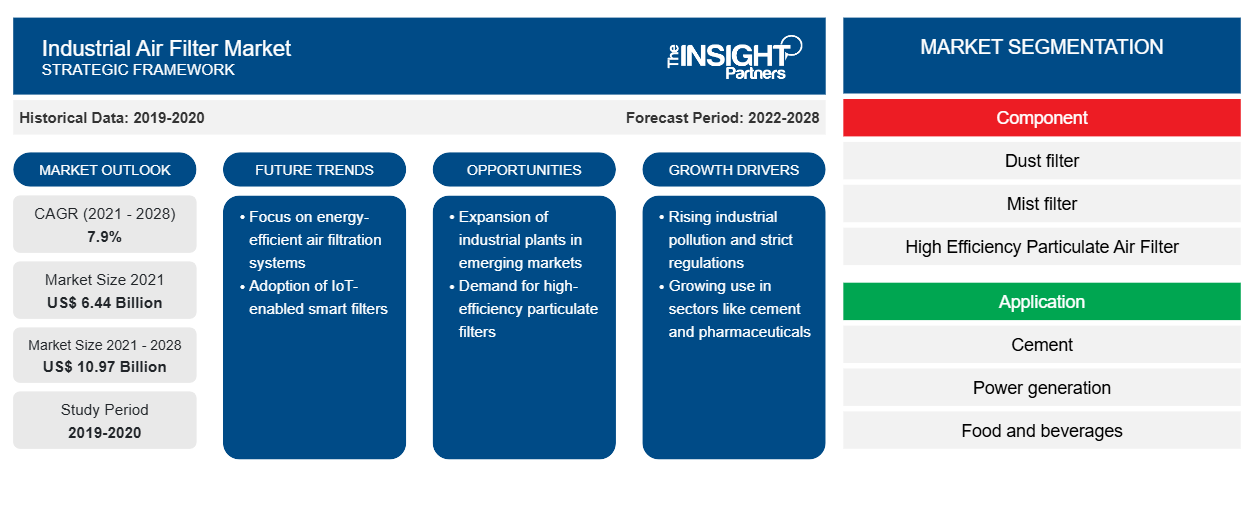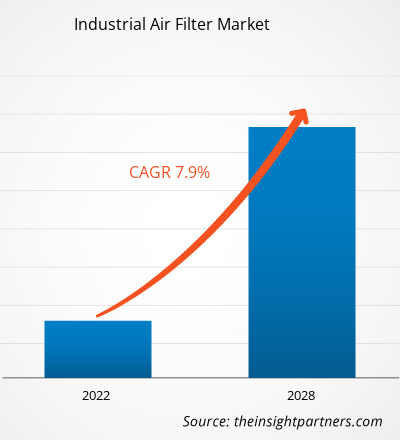[연구 보고서] 산업용 공기 필터 시장은 2021년 64억 4천만 달러에서 2028년 109억 7천만 달러로 성장할 것으로 예상되며, 2021~2028년 동안 연평균 성장률 7.9%로 성장할 것으로 추산됩니다.
분석가 관점:
산업용 공기 필터 시장은 최근 몇 년 동안 상당히 성장하고 확대되었습니다. 이는 산업 현장에서 공기 여과 시스템 수요를 주도하는 몇 가지 주요 요인에 기인할 수 있습니다. 주요 동인 중 하나는 전 세계 다양한 부문에서 산업화가 빠르게 진행되고 있다는 것입니다. 산업이 확장되고 생산 공정이 강화됨에 따라 공기 중 오염 물질과 오염 물질이 증가합니다. 따라서 최적의 공기 질을 유지하고 근로자의 건강을 보호하기 위해 효과적인 공기 여과 시스템을 구현해야 합니다. 시장 성장에 기여하는 또 다른 중요한 요인은 정부 및 환경 기관의 공기 질 기준 및 규정이 강화되고 있다는 것입니다. 이러한 규정은 산업 운영으로 인해 대기 중으로 방출되는 배출물과 오염 물질을 최소화하는 것을 목표로 합니다. 결과적으로 산업은 이러한 엄격한 기준을 준수하기 위해 고급 공기 여과 기술에 투자해야 합니다.
또한, 산업 이해 관계자들 사이에서 생산성, 근로자 웰빙, 전반적인 운영 효율성에 대한 열악한 공기 질이 미치는 해로운 영향에 대한 인식이 높아지고 있습니다. 산업용 공기 필터는 먼지, 연기, 화학 물질, 알레르기 유발 물질과 같은 공기에서 유해한 입자를 제거하여 보다 건강하고 안전한 작업 환경을 조성하는 데 중요한 역할을 합니다. 산업용 공기 필터 시장은 제조, 자동차, 제약, 식품 가공, 화학 공장, 전자 제품을 포함한 다양한 산업 부문에 적합한 다양한 제품을 포함합니다. 이러한 필터는 각 산업의 특정 요구 사항에 따라 크기, 효율성 및 기술이 다릅니다.
시장 개요:
실내 및 실외 공기의 질을 향상시키기 위해 공기 필터는 공기의 불순물을 줄이거나 제거합니다. 모든 난방, 환기 및 공조 시스템에는 공기에서 이물질을 제거하기 위한 산업용 공기 필터가 필요합니다. 산업용 공기 필터는 공정에서 연기와 오염 물질이 발생하는 모든 사업에 필수적입니다. 이러한 필터는 꽃가루, 먼지 및 화학 오염 물질과 같은 오염 물질을 걸러내어 밀폐된 환경에서 실내 공기 질(IAQ)을 유지합니다. 산업용 공기 필터는 또한 오염 물질이 산업 기계 에 유입되는 것을 방지하여 큰 이물질로 인한 기계 손상 위험을 줄입니다.
귀하의 요구 사항에 맞게 이 보고서를 사용자 정의하세요
이 보고서의 일부 또는 국가 수준 분석, Excel 데이터 팩을 포함하여 모든 보고서에 대한 사용자 정의를 무료로 받을 수 있으며 신생 기업 및 대학을 위한 훌륭한 혜택과 할인 혜택을 이용할 수 있습니다.
- 이 보고서의 주요 시장 동향을 알아보세요.이 무료 샘플에는 시장 동향부터 추정 및 예측까지 다양한 데이터 분석이 포함됩니다.
시장 동인:
건강과 안전에 대한 인식 증가로 산업용 공기 필터 시장 성장 촉진
산업 현장에서 건강과 안전에 대한 인식이 커지면서 산업용 공기 필터 시장 성장이 촉진되는 데 중요한 역할을 합니다. 조직과 산업이 공기 질이 근로자의 웰빙과 안전에 미치는 영향을 더욱 의식하게 되면서 깨끗하고 건강한 실내 환경을 조성하는 데 더욱 중점을 두고 있습니다. 이러한 인식으로 인해 효과적인 공기 여과 시스템에 대한 수요가 증가하여 시장 성장이 촉진됩니다. 조직은 근로자의 웰빙을 우선시하며, 공기 질이 좋지 않으면 호흡기 문제, 알레르기 및 직업병이 발생할 수 있음을 인식합니다. 회사는 고품질 공기 여과 시스템에 투자하여 실내 공기 질을 개선하고 직원에게 안전한 작업 환경을 제공하고자 합니다. 근로자 웰빙에 대한 이러한 집중은 산업용 공기 필터에 대한 수요를 촉진하여 시장 성장에 기여합니다.
정부와 규제 기관은 엄격한 직업 건강 및 안전 규정을 부과합니다. 이러한 규정에는 종종 산업 환경에서 허용 가능한 공기 질 기준을 유지하기 위한 특정 요구 사항이 포함됩니다. 조직은 벌금과 법적 책임을 피하기 위해 이러한 규정을 인정해야 합니다. 이러한 규정 준수 요구 사항을 충족하는 효과적인 공기 여과 시스템에 대한 수요가 증가하고 있으며, 이는 시장 성장을 더욱 촉진합니다. 깨끗하고 건강한 실내 공기 질은 근로자 생산성과 전반적인 운영 효율성에도 직접적인 영향을 미칩니다. 직원이 깨끗한 공기에 노출되면 건강 문제가 줄어들고 피로가 감소하며 집중력이 향상됩니다. 이를 인식한 조직은 산업용 공기 필터에 투자하여 근로자의 성과를 최적화하고 궁극적으로 생산성과 운영 효율성을 개선합니다.
또한 직원의 건강과 안전을 우선시하는 조직은 긍정적인 평판과 브랜드 이미지를 구축할 수 있습니다. 소비자, 투자자, 인재는 근로자 복지와 환경적 지속 가능성에 전념하는 기업을 지원하는 경향이 점점 커지고 있습니다. 깨끗하고 건강한 작업 환경을 제공하기 위해 고급 공기 여과 시스템에 투자함으로써 기업은 평판을 높이고 시장에서 경쟁 우위를 확보할 수 있습니다. 산업 환경에서 건강과 안전에 대한 인식이 높아지는 것도 변화하는 소비자 선호도를 반영합니다. 소비자는 이제 구매하는 제품과 지원하는 회사를 더 의식하고 있습니다. 그들은 근로자 복지와 환경적 책임을 우선시하는 기업을 선호합니다. 따라서 산업용 공기 필터를 통해 깨끗하고 건강한 공기 질을 제공하는 데 전념하는 조직은 이러한 소비자 선호도에 맞춰 시장에서 유리한 위치를 차지할 수 있습니다.
세그먼트 분석:
제품 기준으로 산업용 공기 필터 시장은 먼지 필터, 미스트 필터, 백하우스 필터, 카트리지 수집기 및 필터(CC 및 F), HEPA 필터, 습식 스크러버, 건식 스크러버로 나뉩니다. 습식 스크러버 세그먼트는 2020년에 시장에서 가장 큰 점유율을 차지했으며 예측 기간 동안 시장에서 가장 높은 CAGR을 기록할 것으로 예상됩니다. 습식 스크러버는 여러 가지 이유로 지배적인 산업용 공기 필터 시장 세그먼트로 부상했습니다. 오염 물질 제거에 높은 효율성, 산업 전반에 걸친 다양성, 엄격한 배출 규정 준수를 제공합니다. 습식 스크러버는 유해 물질을 효과적으로 제거하고 입자상 물질을 제어하므로 다양한 산업 분야에서 선호되는 선택입니다. 기술적 진보, 비용 효율성 및 장기적 이점이 시장을 더욱 지배합니다. 전반적으로 습식 스크러버의 포괄적인 오염 물질 제거 기능과 광범위한 응용 분야는 산업용 공기 필터 시장에서 선도적인 솔루션으로서의 입지를 확보했습니다.
지역 분석:
북미 산업용 공기 필터 시장은 2021년에 21억 달러 규모로 평가되었으며 2028년까지 345만 달러에 도달할 것으로 예상됩니다. 예측 기간 동안 7.4%의 CAGR로 성장할 것으로 예상됩니다. 북미 지역은 산업용 공기 필터 산업에서 지배적인 시장으로 부상했으며, 이는 주로 선도적 위치에 기여하는 몇 가지 주요 요인 때문입니다. 첫째, 북미는 특히 미국과 캐나다와 같은 국가에서 엄격한 환경 규정을 시행하는 것으로 알려져 있습니다. 이러한 규정은 대기 오염을 통제하고 줄이고, 대기 질을 개선하고, 공중 보건을 보호하는 것을 목표로 합니다. 북미의 산업 부문은 이러한 엄격한 배출 기준을 준수해야 하며, 이로 인해 고급 공기 여과 기술에 대한 수요가 발생합니다. 이 지역의 기업은 이러한 규정을 준수하는 것을 우선시하여 산업용 공기 필터의 채택률이 높아집니다. 둘째, 북미는 잘 발달되고 다양한 산업 부문을 보유하고 있습니다. 북미의 높은 산업화와 산업 활동으로 인해 상당한 배출 및 오염 물질이 대기 중으로 방출됩니다. 환경 문제를 해결하고 근로자의 건강을 보호하기 위해 북미 산업은 첨단 공기 여과 시스템에 투자합니다. 따라서 이 지역의 산업용 공기 필터 수요는 다른 지역보다 높습니다.
또한 북미는 기술 발전과 혁신의 문화가 특징입니다. 이 지역은 강력한 연구 개발 인프라를 갖추고 있어 최첨단 공기 여과 기술의 지속적인 개발을 가능하게 합니다. 북미의 제조업체는 높은 효율성과 향상된 성능을 제공하는 고급 여과 솔루션을 개발하고 상용화하는 데 앞장서고 있습니다. 이러한 기술적 리더십은 북미 기업에 경쟁 우위를 제공하고 이 지역의 산업용 공기 필터 시장 지배력에 기여합니다. 또한 북미에서 공기 질의 중요성에 대한 인식이 커지면서 산업용 공기 필터 채택이 증가하는 원동력이 되었습니다. 산업과 개인 모두 깨끗한 공기의 건강 및 환경적 이점을 점점 더 인식하고 있습니다. 이러한 인식이 높아짐에 따라 공기 여과 솔루션에 대한 수요가 커져 북미 시장 성장이 더욱 촉진되었습니다.
주요 플레이어 분석:
산업용 공기 필터 시장 분석은 Honeywell International Inc, MANN+HUMMEL International GmbH & Co, Beko Technologies, Sentry Air Systems, Nordic Air Filteration A/S, Donaldson Company, Filtration Group Industrial, Pall Corporation, General Filter Italia, Camfil 등의 업체로 구성되어 있습니다. 산업용 공기 필터 업체 중에서 Honeywell International Inc와 Donaldson Company는 다양한 제품 포트폴리오로 인해 상위 2개 업체입니다.
산업용 공기 필터 시장 지역 통찰력
Insight Partners의 분석가들은 예측 기간 동안 산업용 공기 필터 시장에 영향을 미치는 지역적 추세와 요인을 철저히 설명했습니다. 이 섹션에서는 북미, 유럽, 아시아 태평양, 중동 및 아프리카, 남미 및 중미의 산업용 공기 필터 시장 세그먼트와 지리에 대해서도 설명합니다.

- 산업용 공기 필터 시장에 대한 지역별 특정 데이터를 얻으세요
산업용 에어 필터 시장 보고서 범위
| 보고서 속성 | 세부 |
|---|---|
| 2021년 시장 규모 | 64억 4천만 달러 |
| 2028년까지 시장 규모 | 109억 7천만 달러 |
| 글로벌 CAGR (2021-2028) | 7.9% |
| 역사적 데이터 | 2019-2020 |
| 예측 기간 | 2022-2028 |
| 다루는 세그먼트 | 구성 요소별로
|
| 포함된 지역 및 국가 | 북아메리카
|
| 시장 선도 기업 및 주요 회사 프로필 |
|
산업용 공기 필터 시장 참여자 밀도: 비즈니스 역학에 미치는 영향 이해
산업용 공기 필터 시장은 소비자 선호도의 변화, 기술 발전, 제품의 이점에 대한 인식 증가와 같은 요인으로 인해 최종 사용자 수요가 증가함에 따라 빠르게 성장하고 있습니다. 수요가 증가함에 따라 기업은 제품을 확장하고, 소비자의 요구를 충족하기 위해 혁신하고, 새로운 트렌드를 활용하여 시장 성장을 더욱 촉진하고 있습니다.
시장 참여자 밀도는 특정 시장이나 산업 내에서 운영되는 회사나 기업의 분포를 말합니다. 주어진 시장 공간에 얼마나 많은 경쟁자(시장 참여자)가 존재하는지 그 규모나 전체 시장 가치에 비해 나타냅니다.
산업용 공기 필터 시장에서 운영되는 주요 회사는 다음과 같습니다.
- 허니웰 인터내셔널 주식회사
- 맨앤후멜 GmbH
- 노르딕 에어 필트레이션
- 도날드슨 회사, 주식회사
- 일반 필터 이탈리아
면책 조항 : 위에 나열된 회사는 어떤 특별한 순서에 따라 순위가 매겨지지 않았습니다.

- 산업용 공기 필터 시장의 주요 주요 업체 개요를 알아보세요
최근 개발 사항:
합병 및 인수와 같은 무기적 및 유기적 전략은 산업용 공기 필터 시장의 회사에서 널리 채택됩니다. 최근 몇 가지 주요 시장 개발은 다음과 같습니다.
- 2021년 11월, 알파라발은 가스 연소 장치 2.0으로 LNG 포트폴리오를 강화했습니다. 이 새로운 투자는 회사가 여러 걸프 국가로 영토를 확장하는 데 도움이 될 것입니다.
- Eaton은 2021년 9월 Fill Limit Vent Valve(FLVV)와 새로운 Zero-Leak Grade Vent Valve(GVV)를 쌓아 탱크 내 유해한 증발 연료 증기를 안전하게 배출하는 새로운 Zero-leak Compact Combo Valve를 출시했습니다.
- 역사적 분석(2년), 기준 연도, CAGR을 포함한 예측(7년)
- PEST 및 SWOT 분석
- 시장 규모 가치/양 - 글로벌, 지역, 국가
- 산업 및 경쟁 환경
- Excel 데이터 세트


- 3D Audio Market
- Integrated Platform Management System Market
- Clear Aligners Market
- Trade Promotion Management Software Market
- Portable Power Station Market
- Lymphedema Treatment Market
- Dealer Management System Market
- Retinal Imaging Devices Market
- Adaptive Traffic Control System Market
- Sexual Wellness Market

Report Coverage
Revenue forecast, Company Analysis, Industry landscape, Growth factors, and Trends

Segment Covered
This text is related
to segments covered.

Regional Scope
North America, Europe, Asia Pacific, Middle East & Africa, South & Central America

Country Scope
This text is related
to country scope.
자주 묻는 질문
This demand is mainly driven by an end-user preference for environmentally friendly air filters to reduce industrial workers' health risks. Manufacturers are increasingly creating energy-efficient air filters, such as rigid cellular filters, pleated filters, and pocket filters, that is both efficient and simple to install. Clarcor, for example, is a market participant that produces high-efficiency HVAC filters and antimicrobial filters that work in all climates. Furthermore, the rising desire for better environmental conditions in the residential and commercial sectors may present profitable prospects for the industrial air filter market. Furthermore, Camfil introduced the Absolute V, an energy-efficient HEPA air filter, in February 2020. It saves 20% of the energy used. Moreover, In April 2020, Parker presents an energy-efficient HVAC filter. HVAC systems for food processing, microelectronics production, clean manufacturing facilities, hospitals and healthcare facilities, and industrial manufacturing use Parker QuadSEAL 4 in filters. Thus, increasing demand for energy-efficient and higher-performing air filtration technologies is expected to propel the industrial air filter market forward.
on the basis of application the market is sub-segmented into cement, food and beverages, metals, power generation, pharmaceutical, chemical, oil and gas, others. The power generations segment led the industrial air filter market.
Based on product, the market is segmented as Dust Filters, Mist Filters, Baghouse Filters, Cartridge Collectors and Filters (CC and F), HEPA Filters, Wet Scrubbers, Dry Scrubbers. The dry scrubbers segment led the industrial air filter market with a market share of XX% in 2020. Further, it is expected to garner XX% share by 2028
With rising levels of air pollution worldwide, regulatory bodies have implemented various clean air regulations, prompting several sectors to integrate air filter units into their systems, which is a driving factor for market growth. Increased industrialization worldwide, such as in the cement, metal processing, pharmaceutical, and chemical industries, is another element driving expansion. Pollutants are also managed and monitored as a result of growing environmental concerns that promote business expansion. Over time, high capital investment works as a stifling factor for sector competitiveness. Production and installation of such components into the system is a costly event, which impedes the industries' expansion.
The key companies operating in the field of industrial air filter market that are profiled in the report include Honeywell International Inc, MANN+HUMMEL International GmbH & Co, Beko Technologies, Sentry Air Systems, Nordic Air Filteration A/S, Donaldson Company, Filtration Group Industrial, Pall Corporation, General Filter Italia, Camfil among many others.
Some of the most recent filtration advancements are based on new developments in filter design and media technology, fueled by legislative responses to climate change and rising GHG emissions. Filtration system designers and plant managers can now reduce their operating costs and save energy while maintaining the highest quality standards and achieving a performance boost thanks to innovative filtration products. There are numerous advancements in air filtering technologies for industrial uses, including automotive and other industrial applications, profiling breakthroughs such as Capaceon, NANOWEB, NanoWave, Synteq XP, PowerCore, and Ultra-Web. For instance, Donaldson, a prominent global provider of filtration systems and replacement parts, recently introduced Synteq XP compressed air filter media, which the firm claims boosts efficiency while decreasing energy consumption by as much as 40% due to a much lower media delta pressure. Furthermore, Hollingsworth & Vose Company designed and developed NanoWave, an all-synthetic extended surface, high-loft material that is environmentally friendly. The material has three times the dirt retention capacity of standard media and was designed for the ASHRAE (American Society of Heating, Refrigeration, and Air Conditioning Engineers)-certified HVAC bag filter media market. Delta pressure levels are projected to fall more in the coming years as filtering efficiency is required. The pressure to satisfy increased environmental demands develops, and new inventions, such as advancements in nanotechnology, are introduced to the market. Moreover, inhibited oxidation, for instance, has various advantages in wet scrubbers, including low reagent cost, reduced reagent usage, and low overall life cycle cost. In the suppressed oxidation process, emulsified sulphur is added to the reagent feed tank, lowering the oxidation rate to less than 15% and permitting the use of less expensive materials by removing the corrosion mechanism. Thus, the market for industrial air filter is expected to be driven by such advanced technologies and tools.
Trends and growth analysis reports related to Manufacturing and Construction : READ MORE..
The List of Companies - Industrial Air Filter Market
- Honeywell International, Inc.
- Mann + Hummel GmbH
- NORDIC AIR FILTRATION
- Donaldson Company, Inc
- GENERAL FILTER ITALIA
- Camfil AB
- Paul Corporation
- FILTRATION GROUP INDUSTRIAL
- SENTRY AIR SYSTEMS, INC
- AIR FILTERS, INC.
The Insight Partners performs research in 4 major stages: Data Collection & Secondary Research, Primary Research, Data Analysis and Data Triangulation & Final Review.
- Data Collection and Secondary Research:
As a market research and consulting firm operating from a decade, we have published and advised several client across the globe. First step for any study will start with an assessment of currently available data and insights from existing reports. Further, historical and current market information is collected from Investor Presentations, Annual Reports, SEC Filings, etc., and other information related to company’s performance and market positioning are gathered from Paid Databases (Factiva, Hoovers, and Reuters) and various other publications available in public domain.
Several associations trade associates, technical forums, institutes, societies and organization are accessed to gain technical as well as market related insights through their publications such as research papers, blogs and press releases related to the studies are referred to get cues about the market. Further, white papers, journals, magazines, and other news articles published in last 3 years are scrutinized and analyzed to understand the current market trends.
- Primary Research:
The primarily interview analysis comprise of data obtained from industry participants interview and answers to survey questions gathered by in-house primary team.
For primary research, interviews are conducted with industry experts/CEOs/Marketing Managers/VPs/Subject Matter Experts from both demand and supply side to get a 360-degree view of the market. The primary team conducts several interviews based on the complexity of the markets to understand the various market trends and dynamics which makes research more credible and precise.
A typical research interview fulfils the following functions:
- Provides first-hand information on the market size, market trends, growth trends, competitive landscape, and outlook
- Validates and strengthens in-house secondary research findings
- Develops the analysis team’s expertise and market understanding
Primary research involves email interactions and telephone interviews for each market, category, segment, and sub-segment across geographies. The participants who typically take part in such a process include, but are not limited to:
- Industry participants: VPs, business development managers, market intelligence managers and national sales managers
- Outside experts: Valuation experts, research analysts and key opinion leaders specializing in the electronics and semiconductor industry.
Below is the breakup of our primary respondents by company, designation, and region:

Once we receive the confirmation from primary research sources or primary respondents, we finalize the base year market estimation and forecast the data as per the macroeconomic and microeconomic factors assessed during data collection.
- Data Analysis:
Once data is validated through both secondary as well as primary respondents, we finalize the market estimations by hypothesis formulation and factor analysis at regional and country level.
- Macro-Economic Factor Analysis:
We analyse macroeconomic indicators such the gross domestic product (GDP), increase in the demand for goods and services across industries, technological advancement, regional economic growth, governmental policies, the influence of COVID-19, PEST analysis, and other aspects. This analysis aids in setting benchmarks for various nations/regions and approximating market splits. Additionally, the general trend of the aforementioned components aid in determining the market's development possibilities.
- Country Level Data:
Various factors that are especially aligned to the country are taken into account to determine the market size for a certain area and country, including the presence of vendors, such as headquarters and offices, the country's GDP, demand patterns, and industry growth. To comprehend the market dynamics for the nation, a number of growth variables, inhibitors, application areas, and current market trends are researched. The aforementioned elements aid in determining the country's overall market's growth potential.
- Company Profile:
The “Table of Contents” is formulated by listing and analyzing more than 25 - 30 companies operating in the market ecosystem across geographies. However, we profile only 10 companies as a standard practice in our syndicate reports. These 10 companies comprise leading, emerging, and regional players. Nonetheless, our analysis is not restricted to the 10 listed companies, we also analyze other companies present in the market to develop a holistic view and understand the prevailing trends. The “Company Profiles” section in the report covers key facts, business description, products & services, financial information, SWOT analysis, and key developments. The financial information presented is extracted from the annual reports and official documents of the publicly listed companies. Upon collecting the information for the sections of respective companies, we verify them via various primary sources and then compile the data in respective company profiles. The company level information helps us in deriving the base number as well as in forecasting the market size.
- Developing Base Number:
Aggregation of sales statistics (2020-2022) and macro-economic factor, and other secondary and primary research insights are utilized to arrive at base number and related market shares for 2022. The data gaps are identified in this step and relevant market data is analyzed, collected from paid primary interviews or databases. On finalizing the base year market size, forecasts are developed on the basis of macro-economic, industry and market growth factors and company level analysis.
- Data Triangulation and Final Review:
The market findings and base year market size calculations are validated from supply as well as demand side. Demand side validations are based on macro-economic factor analysis and benchmarks for respective regions and countries. In case of supply side validations, revenues of major companies are estimated (in case not available) based on industry benchmark, approximate number of employees, product portfolio, and primary interviews revenues are gathered. Further revenue from target product/service segment is assessed to avoid overshooting of market statistics. In case of heavy deviations between supply and demand side values, all thes steps are repeated to achieve synchronization.
We follow an iterative model, wherein we share our research findings with Subject Matter Experts (SME’s) and Key Opinion Leaders (KOLs) until consensus view of the market is not formulated – this model negates any drastic deviation in the opinions of experts. Only validated and universally acceptable research findings are quoted in our reports.
We have important check points that we use to validate our research findings – which we call – data triangulation, where we validate the information, we generate from secondary sources with primary interviews and then we re-validate with our internal data bases and Subject matter experts. This comprehensive model enables us to deliver high quality, reliable data in shortest possible time.


 이 보고서에 대한 무료 샘플을 받으세요
이 보고서에 대한 무료 샘플을 받으세요